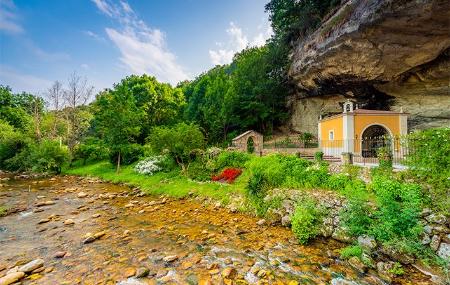
Pola de Laviana to Infiesto
- Address Laviana, Caso, Sobrescobio and Piloña Central and Eastern Asturias
- Distance Distance: 48 kms
- Difficulty Difficulty: Half
- Mountain bike Mountain bike: 1 day
- Start point Start point: Pola de Laviana
- Route type Route type: mtb
- Tour type Tour type: Linear
- Layout of the route Layout of the route: Download kml, Download gpx
Route
La Pola Llaviana/Pola de Laviana (Laviana) - L'Infiestu (Piloña) 48
This cycling tour is linear, starting and finishing at different points. There will be some tough sections - details are given below - which may be difficult for people who are not used to cycling, but it is beautiful and peaceful, especially from the turn-off to Gobezanes. It runs along asphalted areas or well-compacted paths, making it suitable for all types of bicycles.
La Collada de Arnicio - 915 metres high - is a small mountain pass that joins the capitals of the councils of Piloña -Infiesto- and Caso -Campo de Caso- by a winding road. In this beautiful bicycle ride we will connect one of the mining valleys par excellence with a cider valley. The initial departure from Pola de Laviana does not represent any problem due to its smooth profile. This is done along the AS-117a road (or alternatively along the cycle path along the banks of the river Nalón) up to the Chalana bridge. Then continue along the road, passing through villages such as Iguanzo (with its history of the "fielato"), bridges (such as Puente del Arco) and towers (such as the Torreón de El Condado).
Once past the village of El Condado, join the road (AS-117) to Puerto Tarna and go up to the Rioseco reservoir. There is a tunnel in this section, so it is essential to carry lights and reflective clothing to see and be seen. From here, the route enters the council of Sobrescobio (and therefore the Redes Natural Park).
After a stop to contemplate the reservoir from the village of Rioseco, the climb becomes steeper due to the kilometre and a half it takes to go up the Tanes dam. It is a tough but beautiful stretch, especially if you look at the area where the road and the river are boxed in. Once at the top, it is possible to look out for a moment to see the vertiginous leap that the river Nalón has to make to reach the dam. By the way, did you know that the Rioseco and Tanes dams are connected by underground pipes?
Once in the village of Tanes, it is worth visiting the Collegiate Church of Santa María La Real which, being located on a natural terrace on the edge of the reservoir, seems to be captivated by its waters. Shortly after leaving Tanes, turn off in the direction of Infiesto/Gobezanes.
On this ascent, the route crosses the beautiful Foz de Gobezanes, recreating our senses among watermills and the lullaby of the river Orlé. At the turn-off to Gobezanes (a village well worth a visit), we continue towards Bueres. Shortly before reaching this village, take the AS-254 road, which you will not leave until the end of this excursion.
From Bueres to the pass that gives its name to this route - the Collada de Arnicio - it is a little less than 4 kilometres uphill with a fairly reasonable gradient. It is advisable to take water in Bueres as there are no more fountains until you reach the pass.
Once at the top you can enjoy the panoramic views and the fresh wind that blows from the peaks of Tiatordos, Taranes and Foyos.
The Casín Cheese Festival is held every year on this pass during the last weekend in August. A complex and lengthy cheese, Queso Casín is made from raw cow's milk. It is a cheese with a high fat content, irregular cylindrical-discoidal shape, strong and powerful aroma, strong and spicy taste (although it depends on the production process), and has a creamy yellow colour, with whitish tones and no rind. The best part of the next stretch will be the 20 kilometres of descent between beautiful sheepfolds until you reach Infiesto. Special care must be taken with the potholes and some of the bends, especially at the entrance to the village of La Marea. On this descent you pass through villages such as Les Cueves, La Marea, Puente Miera, Vegarrionda and Ferreros.
A little before entering Infiesto, the end point of this route, we recommend stopping and visiting the Sanctuary of La Virgen de La Cueva, which is one of the key points of the council of Piloña, located next to its recreational area.
Map
Itinerary
Pola de Laviana - El Condado - Rioseco reservoir - Tanes - Foz de Gobezanes - Collada de Arnicio - Infiesto



